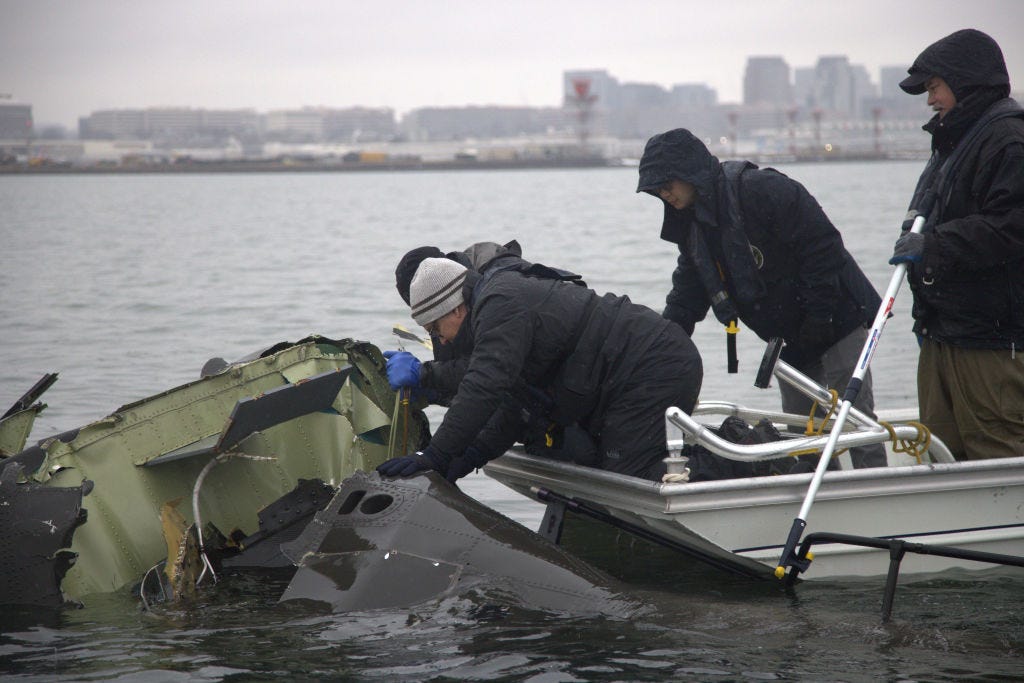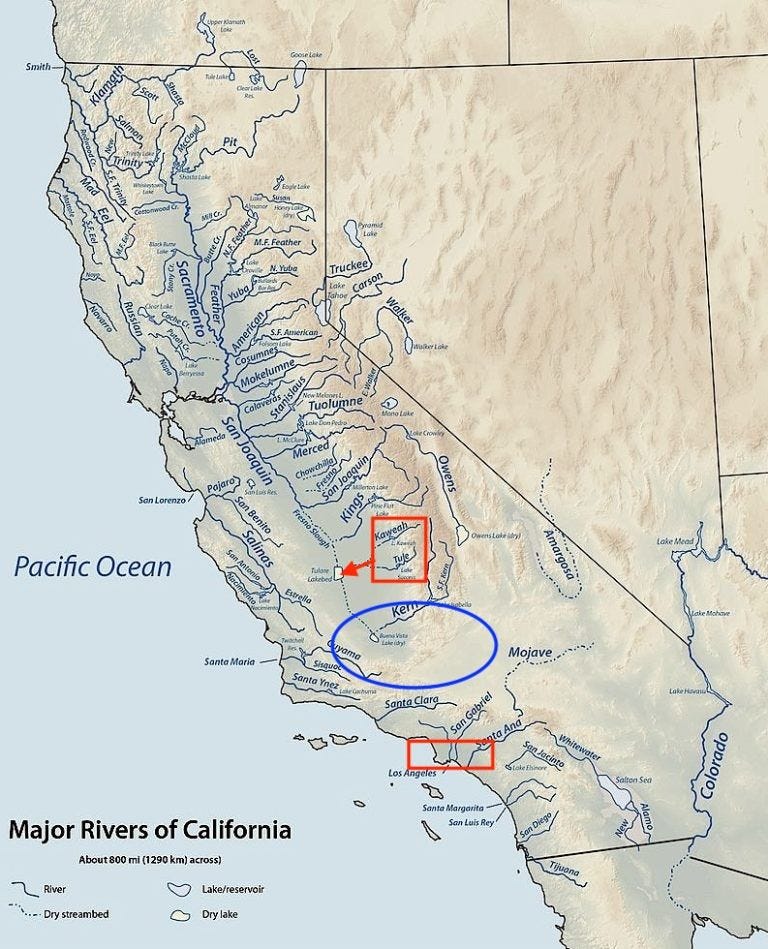‘This is Serious Business. You Better Start Paying Attention.’
The most recent aviation disasters were not the new administration's fault. The next ones likely will be.
An NTSB team pulling wreckage from the Potomac this week, after the deadly crash of an Army Blackhawk helicopter into a regional jet near National Airport in DC. (NTSB photo via Getty Images.)
In these past three weeks we’ve seen what the Trump / Musk / Vought team has done to USAID, to the NIH and CDC, to US relations with allies from Denmark to Canada and the world as a whole, to the Justice Department and the FBI, to the US Treasury and the Social Security administration, and much more of our civic infrastructure. They are just getting started.
I find it useful to keep the three principals’ roles distinct. Trump exists to vent grievance and draw attention, and will say whatever pops into his mind if it keeps him in the news. An example from just yesterday: Trump bragged at a National Prayer Breakfast that he “opened up” water from Northern California and that “millions and millions of barrels” are now “flowing down” to the fire-damaged LA region. His crowd applauded. Here’s what actually occurred (Sharpie-style annotations by me):
The upper red box is where he ordered the Army Corps of Engineers (or “the Army,” as he puts it) to open spillways on two dams. The red arrow is where that water went. The lower red box is Los Angeles, where thanks to recent rains the fires are now completely contained. The blue oval in between is the range of mountains (Tehachapis and San Gabriels) that keep a single drop of water from ever “flowing down” to LA. Either Trump can’t grasp this, and perhaps thinks that north on a map means “up” so water will always flow “down”; or he doesn’t care. What he knows is that the line always brings a cheer from lackeys.
Musk of course is the caricature of a startup bro, with a “move fast and break things” track record (self-driving cars, his tunnel company, Xitter), and with grotesque conflicts of interest across his enormously lucrative contracts and subsidies from the federal government. And Vought is the purposeful creator of Project 2025, for whom dismantling “state capacity” is a goal in itself. The rest of the Republican party serves as a claque.
For now all these vectors are aligned: Trump signs Executive Orders and scowls as he holds them up for the camera; Musk deploys his clueless acolytes to take over agencies; Vought lays out a target list. And in the past few days they have settled on a new object: the Federal Aviation Administration and the nation’s complex but astoundingly successful air-safety system.
Musk has his own grievance against the FAA, which after SpaceX explosions has been scrutinizing and more tightly regulating Musk’s space operations. For Vought, it’s one more federal operation that could be privatized. Trump seems to have settled on the idea that the FAA is a den of “DEI hires,” and that crashes can be blamed on them. He even got his new Secretary of Transportation, Sean Duffy, to make the absurd culture-war claim that the FAA’s use of “flight deck” instead of “cockpit” reflected its loss of edge. (The term “flight deck” has been around almost as long as airplanes have. The term “cockpit” does not have the macho word-origin that Duffy apparently assumed.)
Musk’s announcement of his new mission said that his ninja “Doge” team would “make rapid safety upgrades to the air traffic control system.” Duffy promptly chimed in to say, “We’re going to remake our airspace, and we’re going to do it quickly.”
These are words—rapid, quickly—that should make you worry, for real, about future air travel. A few self-driving cars run over people and slam into other vehicles? An online platform blows up? A few rockets do too? Hey, Musk’s companies can say that’s the cost of progress. But a few airliners hit the ground, and you’ve changed everything about people’s willingness to fly.
I frequently think of the dark quote usually attributed to the Greek philosopher Bion of Borysthenes:
“Boys throw stones at frogs in fun. But the frogs do not die in fun. They die in earnest.”
The Trump/Musk/Vought team may be preparing to shake up the FAA in fun. Passengers will die not in fun but in earnest.
The ‘Opposing Bases’ podcast: How people who take air-safety seriously, talk and think.
The rest of this post will be about an aviation-world podcast episode that I found enormously enlightening, and whose message I hope people inside and outside the flying world—aviation professionals, as well as those crammed into seat 28F—will absorb.
It’s also the most informative view I’ve seen of the tragic helicopter-airliner crash over the Potomac recently, in which 67 people were killed. Realistically I know that most people are not going to sit through a 90-minute discussion about air-traffic procedures over Washington DC. (Though I did listen to the whole thing, and re-listened to parts.) But at a minimum I hope that any reporter covering this issue will check this program out—and that members of the flying public will be aware of its arguments. I’ll mention several of them below.
The podcast is part of a series called ‘Opposing Bases,’ which is itself an aviation term. (It refers to a situation in which airplanes are approaching an airport from opposite directions, and for a while are flying head-to-head, until a controller sequences them in proper order.1)
The hosts of this show are two experienced aviators, each of whom has worked as a pilot and also as an air-traffic controller. In their podcast and at air-show appearances they are introduced only by their two-letter controller IDs: “Alpha Golf,” or AG, and “Romeo Hotel,” or RH.
Their backgrounds are unusually relevant when it comes to the recent DCA disaster. AG is a former Army helicopter pilot who flew many times on the same route along the Potomac as the recent doomed Blackhawk. RH has regularly flown regional jets to landings at DC National Airport, on the same route as the recent doomed American Eagle plane. And as a reminder, both of them have worked for years as air-traffic controllers. They are among the handful of people in the world who have the most direct experience with the setting and circumstances the DCA crash.2
I follow, enjoy, and and learn from their podcast. Usually the hour-long weekly show starts with five or ten minutes of jokey “how was your weekend?” chat. In their latest special installment, “We Discuss the Tragedy at DCA,” they are atypically ultra-serious from beginning to end. The online notes for this episode strike the tone:
This accident will define the next generation responsible for maintaining the safest airspace in the world. Lost loved ones will serve as vivid reminders that life is precious, our time on earth is often unfairly limited, and we must always strive to be better stewards of the aviation transportation system.
The closing words of the podcast are the ones below.
We joke around a lot in the show. But this is a serious business. And you better start paying attention.
At many points in the conversation, the two controller/pilots express frustration and even anger at instant press and political attempts to “assign blame” for the disaster. Donald Trump of course kicked this off less than 24 hours after the collision. Then at NTSB briefings this week some reporters have acted miffed that investigators are not yet ready to declare what went wrong, and why, and who should be held responsible. As AG says early in the show:
The NTSB does this for a living. They are not going to miss anything. And if they have not arrived at a point of deciding what happened… there’s no chance anybody else has.
The episode carefully follows a four-point plan for discussion: What it’s like to fly the low-altitude helicopter routes along the Potomac. What it’s like to fly the DCA approach the airliner followed. What it would have been like inside the DCA control tower that evening. And what the general operating rules and conditions are like in hyper-complex and congested DC airspace.
Here is a summary and a few highlights, with approximate time cues.
1) Low-altitude helicopters along the Potomac.
From around time 15:00 to 33:00 of this podcast, AG, the former Army helicopter pilot, describes going along the Potomac at low altitude, including at night: Why there is always so much helicopter traffic around Washington (time 16:00). The pluses and minuses of wearing night-vision goggles when flying, and how he would need to look around, under, and over the goggles to see the instrument panel or peripheral-vision areas they had blocked off. (Through time 24:00.) Why he relied on paper maps even in an electronics-equipped cockpit (time 25:00) And, crucially, what instructions and clearances helicopter pilots would be getting from controllers. (Essentially, they were cleared to follow the course and altitude limits of an approved route, as depicted on a chart, but not micro-managed for second-by-second heading and altitude. They explain why this matters. Time 27:00 through around 30:00.)
If you want to know what the three people aboard the Blackhawk might have been thinking, what they were seeing, and what they would be paying attention to, I highly recommend this segment.
2) The complexities of landing airplanes at DCA.
From around time 33:00 to 54:00 of the episode, RH, the former commuter jet pilot, describes landing at DCA, especially when given a change-of-runway instruction like that for the American Eagle airplane. (As a reminder: the American Eagle jet was on the “Mount Vernon approach” to the longest runway at DCA, Runway 1. Apparently to sequence a plane about to take off from that same long runway, the controller asked if the American Eagle flight could “accept” a landing on the shorter Runway 33. As the podcast explains, this is a routine situation, and the American Eagle crew said Yes.)
I found this section also jam-packed with insights. For instance: How much it matters that the plane had to land on this shorter Runway 33. (Time 34:00 and onward.) Why DCA’s unique placement—prohibited airspace for the White House and Capitol just to the north of it, the Pentagon immediately beyond it—makes approaches there unusually demanding. (Roughly 35:00 through 40:00.) How much vertical clearance the regional jet crew would have had from the numerous helicopters flying along the river. (Not that much — starting at time 44:00.) Why the normal anti-collision systems for airliners, known as TCAS, don’t really work for planes coming in to land at DCA. (Time 46:00 and following.) And, around time 48:00, why pilots inbound for landing would be, with intense focus, looking at the runway as they came through the final few hundred feet before touchdown, rather than glancing all around them for helicopters or other traffic. As RH put it about that stage of the flight, based on his own landings at DCA:
“Your heart's beating, because if you mess this up, you have to go around and it's totally on you. [“Go around” means aborting the landing and circling around to try again. For Runway 33 at DCA this is unusually tricky, because the “go around” route takes you right over the Pentagon.]
This isn't something you shouldn't be able to do. But it's different, and it's challenging…. It was the flying part of flying. It was what we enjoyed doing, but it was super challenging.”
3) What was happening in the control tower.
Starting around time 54:00 to 1:14:00, the part of the situation that has gotten most press attention: Conditions inside the DCA control tower. This is the part that I most hope fellow reporters will actually listen to and learn from.





